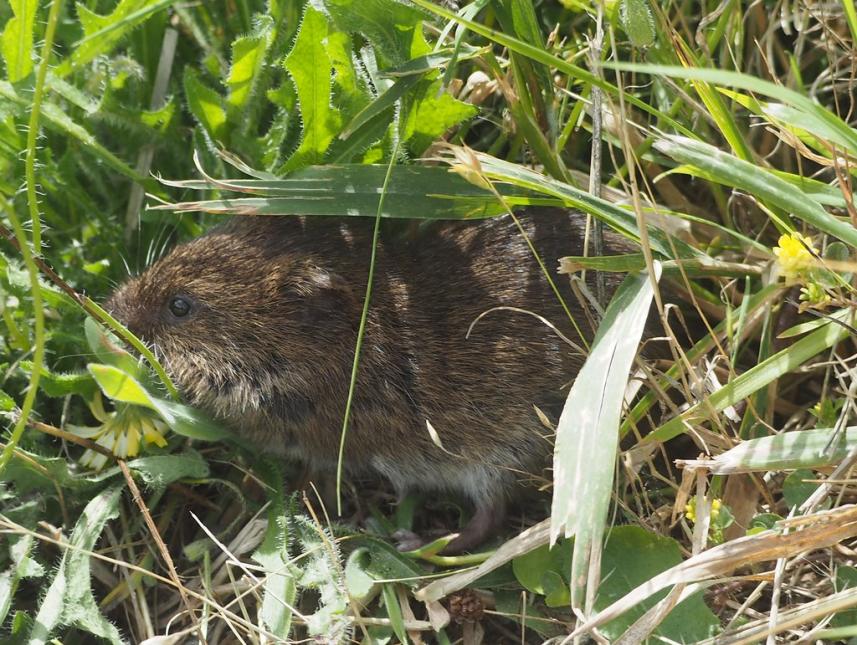Moderate
This subspecies of Microtus townsendii occurs on at least 16 islands in the San Juan Archipelago. Overall population status is unclear, but populations appear secure on several larger islands. Apparent threats include habitat loss and mortality from agricultural practices.
Description and Range
Physical description
Shaw Island Townsend’s voles are small mammals in the Cricetidae family. The vole has brown fur and a longer, dark colored tail. It is a medium-sized vole and shares many characteristics with the more common Townsend's vole. Townsend’s vole is 6 to 10 inches long; their tails are 2 to 3 inches long; and they weigh 1.4 to 3.5 ounces.
Subspecies designation for the Shaw Island Townsend's vole was based on morphometric measurements that differ from other known subspecies of Microtus townsendii. It may be more closely associated with water than other subspecies of M. townsendii.
The type specimen was collected from Neck Point, Shaw Island, Washington, in 1938. Subspecies designation was based on morphometric measurements that differ from other known subspecies of Microtus townsendii. Microtus t. pugeti appears smaller, with wider skull characteristics compared to other subspecies. The Shaw Island Townsend’s vole may be more closely associated with water than other subspecies of M. townsendii. The original taxonomic designation has not been re-evaluated.
Ecology and life history
Shaw Island Townsend’s voles have been found in fresh, brackish, and salt water marshes, under driftwood on beaches, as well as in dry fields, forests, and agricultural fields. Specific habitat requirements or limitations are unknown.
These voles live in underground burrows and open grasslands, and are primarily vegetarian. The subspecies’ presence can often be recognized by travel runways that are clipped and maintained within their territories.
Geographic range
The Shaw Island townsend's vole is found only in the San Juan Archipelago. Museum specimens from the late 1930s to the 1960s exist from Allen, Cypress, Deception, Dot, Frost, Guemes, Lopez, Orcas, Saddlebag, San Juan, Shaw, Sucia, and Turn islands in San Juan and Skagit counties. Island residents reported voles present on Henry and McConnel islands in the late 1960s.
Surveys conducted in 2012 and 2014 confirmed presence on Lopez, Orcas, San Juan, and North Finger islands, but did not detect them on Blakely, Vendovi, or Waldron islands. Recent surveys on other islands have not been conducted and population status is unknown.
Populations appear to be robust where they occur on Lopez, Orcas, San Juan, and North Finger islands, but no formal population assessments have been conducted for this subspecies.
Climate vulnerability
Sensitivity to climate change
Moderate
Unpublished information indicates that Shaw Island Townsend's voles are commonly found in or near coastal marshy areas. Voles also occur in dry upland areas, but are usually (although not always) less numerous in such habitats. The widespread use of coastal marshy areas indicates that this subspecies could be vulnerable to sea level rise. Evidence also suggests that these voles are less active during hot dry spells, when they may remain underground in their burrows and rely on cached food. They may therefore be vulnerable to prolonged drought if stored food supplies are insufficient. Extended periods of dry weather might also alter the phenology of food plants by causing premature drying, thus perhaps reducing vole survival and reproductive success.
Exposure to climate change
Moderate
- Sea level rise
- Drought
- Changes in phenology of food plants
Conservation
Conservation Threats and Actions Needed
- Fish and wildlife habitat loss or degradation
- Threat: Conversion to agriculture and other human development. Habitat fragmentation may isolate remaining populations.
- Action Needed: Develop better understanding of species' habitat needs and work with local planners to protect key areas from development
- Threat: Direct mortality occurs from agricultural practices that are unfavorable to Shaw Island Townsend's vole.
- Action Needed: Work with farmers to increase tolerance for voles; develop methods for compatible farming practices.
- Resource information collection needs
- Threat: Subspecies designation is based on morphological comparisons in the 1940s.
- Action Needed: Need genetic assessment to determine validity of the current subspecies designation.
- Threat: Current data regarding distribution among islands and population estimates do not exist.
- Action Needed: Conduct surveys on all likely islands, including population assessments.
Resources
References
Hafner, D. J., E. Yensen, and G. L. Kirkland, Jr. (compilers and editors). 1998. North American rodents: status survey and conservation action plan. IUCN/SSC Rodent Specialist Group, IUCN, Gland, Switzerland and Cambridge, United Kingdom.
Other resources
